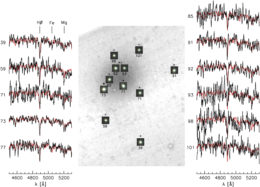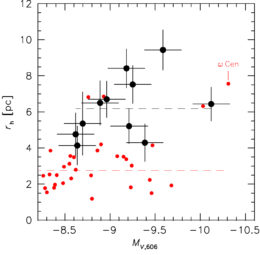You may have seen recent news about NGC 1052–DF2, a galaxy that was discovered to have little or no dark matter. Now, a new study explores what NGC 1052–DF2 does have: an enigmatic population of unusually large and luminous globular clusters.

Keck/LRIS spectra (left and right) and HST images (center) of the 11 clusters associated with NGC 1052–DF2. The color images each span 1” × 1”. [van Dokkum et al. 2018]
An Unusual Dwarf
The ultra-diffuse galaxy NGC 1052–DF2, originally identified with the Dragonfly Telescope Array, has puzzled astronomers since the discovery that its dynamical mass — determined by the motions of globular-cluster-like objects spotted within it — is essentially the same as its stellar mass. This equivalence implies that the galaxy is strangely lacking dark matter; the upper limit set on its dark matter halo is 400 times smaller than what we would expect for such a dwarf galaxy.
Led by Pieter van Dokkum (Yale University), the team that made this discovery has now followed up with detailed Hubble Space Telescope imaging and Keck spectroscopy. Their goal? To explore the objects that allowed them to make the dynamical-mass measurement: the oddly bright globular clusters of NGC 1052–DF2.

Sizes (circularized half-light radii) vs. absolute magnitudes for globular clusters in NGC1052–DF2 (black) and the Milky Way (red). [Adapted from van Dokkum et al. 2018]
What’s Up with the Globular Clusters?
Van Dokkum and collaborators spectroscopically confirmed 11 compact objects associated with the faint galaxy. These objects are globular-cluster-like in their appearance, but the peak of their luminosity distribution is offset by a factor of four from globular clusters of other galaxies; these globular clusters are significantly brighter than is typical.
Using the Hubble imaging, the authors determined that NGC 1052–DF2’s globular clusters are more than twice the size of the Milky Way’s globular clusters in the same luminosity range. As is typical for globular clusters, they are an old (~9.3 billion years) population and metal-poor.
Rethinking Formation Theories
The long-standing picture of galaxies has closely connected old, metal-poor globular clusters to the galaxies’ dark-matter halos. Past studies have found that the ratio between the total globular-cluster mass and the overall mass of a galaxy (i.e., all dark + baryonic matter) holds remarkably constant across galaxies — it’s typically ~3 x 10-5. This has led researchers to believe that properties of the dark-matter halo may determine globular-cluster formation.

The luminosity function of the compact objects in NGC 1052–DF2. The red and blue curves show the luminosity functions of globular clusters in the Milky Way and in the typical ultra-diffuse galaxies of the Coma cluster, respectively. NGC 1052–DF2’s globular clusters peak at a significantly higher luminosity. [Adapted from van Dokkum et al. 2018]
As with all unexpected discoveries in astronomy, we must now determine whether NGC 1052–DF2 is simply a fluke, or whether it represents a new class of object we can expect to find more of. Either way, this unusual galaxy is forcing us to rethink what we know about galaxies and the star clusters they host.
Citation
Pieter van Dokkum et al 2018 ApJL 856 L30. doi:10.3847/2041-8213/aab60b

4 Comments
Pingback: Dwarf galaxy Dark Matter content is most revealing
Pingback: Weitere Artikel dieses Blogger seit dem 2. April | Skyweek Zwei Punkt Null
Pingback: Abril 2018 – Observatori Astronòmic
Pingback: Dark Matter in NGC 1052-DF2: A Matter of Debate